In times of crisis, we often look to our favourite celebrities to see if they share our moral beliefs. When they don't, we label them as ugly. But why do we associate beauty with morality, and how does it impact our perception of the world?
Over the last few months, it’s become increasingly clear that Timothée Chalamet, the golden boy of Hollywood, has fallen out of favour among young people. Many believed the day would never come, as Chalamet, with his floppy brown hair and “intense” green eyes, played gut-wrenchingly sensitive characters in Call Me By Your Name (2017), Beautiful Boy (2018) and Little Women (2019). While we watched him desperately pine over Oliver (Armie Hammer) and Jo (Saoirse Ronan), he appealed so perfectly to the desires many young people have about men: that they can be beautiful, kind and sensitive. The vulnerability he displayed in those roles, coupled with his slender frame, meant that he was seen as the antithesis of “toxic masculinity”, and thus, he became known as the internet’s “official boyfriend”. While his position went relatively unchallenged for years, things have started to shift.
As of late, Chalamet’s morality has come into question. From the “joke” he made about Hamas on SNL last year to his relationship with Kylie Jenner, the world’s “youngest self-made billionaire”, he has begun to defy the image of himself that so many of his fans have crafted in their minds. All of this (including his stint as the notoriously unsexy Willy Wonka in Paul King’s Wonka) has resulted in young people not only denouncing his behaviour online but also discussing how Chalamet has become increasingly “ugly” due to his actions. One person’s review of Dune: Part 2 was that Chalamet is “ugly as fuck”, while another X user remarked on a picture of the actor where his face is wrinkled that “God took his looks quick.”
Comments like this aren’t unusual when we’re feeling hurt or betrayed by somebody. Their image erodes in our minds, and individuals we once fancied or admired become physically and internally ugly. For example, Amy Schumer, who is arguably one of the worst people in the world, has also been met with these same comments about her appearance due to her recent weight gain. On the other end of the spectrum, Anne Hathaway is always complimented on her looks and is said to be “ageing well” because she is “unproblematic”. This begs the question: why are we so quick to comment on one’s physical appearance when what we are really criticising is their moral standing?
“It’s because it’s an easy framework,” beauty reporter and critic Jessica DeFino tells Dazed. “It takes a very complex situation and whittles it down to the superficial. Wouldn’t it be so easy if ugly people were bad and pretty people were good and we knew the right person to agree with and the right way to be in the world?” This oversimplification of ‘ugly’ meaning ‘bad’ and ‘beautiful’ meaning ‘good’ is something we are taught from childhood. In The Little Mermaid (1989), Ursula is fat whereas Ariel is thin. In Snow White and the Seven Dwarfs (1937), the Evil Queen was first designed as a fat character, and we’re introduced to her as an ugly older woman. In The Lion King (1994), Scar has a facial disfigurement, as does Zuko, Prince of the Fire Nation in Avatar: The Last Airbender, Voldemort in the Harry Potter franchise, Two-Face in The Dark Knight (2008), and several of James Bond’s adversaries in the 007 films.
god took his looks quick omg https://t.co/oEmcVRYZq5
— jade ♱ (@bl6ckcat) February 15, 2024
In children’s television programmes or movies, the villains often sit outside societal beauty standards. These characters are either fat, disabled, foreign or have a darker complexion than their heroic and morally sound counterparts. In our overtly visual culture, these oversimplifications are believed to be an easy way of communicating who is good and who is bad to younger audiences to ensure they know how to keep themselves safe. However, these depictions suggest that those with darker skin, disabilities, or visual signs of ageing are inherently untrustworthy. It also suggests that signs of ageing, disability or weight gain are punishments for immoral behaviour. In the tweet above about Chalamet, the author states that it was God who took his looks away, highlighting the everpresent belief that beauty and Godliness are connected.
The ancient Greeks believed in this sentiment wholeheartedly, with one of their most fundamental principles being “kalokagathia”. Within ancient Greek philosophy, “kalokagathia served as an aspirational idea,” explains art historian Eugenia Ivanova. “It postulates that an individual possessing physical beauty should also exhibit moral integrity and excellence of character… [It] motivates individuals to strive for a balanced and virtuous life.” In her article, “Escape history’s failings, separate beauty from morality” for The Emory Wheel, Alexandra Kauffman writes that the Greeks, especially those from aristocratic backgrounds, believed so heavily in this philosophy that they would commission artwork of themselves that communicated their internal beauty, externally. It’s one of the reasons the “archaic smile” was so heavily popularised in early Greek sculpture, as it “demonstrated the propagandised pleasantness of the aristocracy, with a subtle tilt of the lips illustrating the eternal happiness of the eternally beautiful”.
“Wouldn’t it be so easy if ugly people were bad and pretty people were good and we knew the right person to agree with and the right way to be in the world?” – Jessica DeFino
Aristocratic Greeks portrayed themselves as beautiful not only for aesthetic validation but as a way to “assert their supremacy as a ruling class deserving of power, as their moral righteousness was so clearly indicated by superior aesthetics,” writes Kauffman. “This artwork sent, and continues to send, a political message.” This belief in appearance relating to morality and then being used to proclaim supremacy over others has been used in our society to justify horrible things. For example, in the 1800s, soap and cleanliness were marketed to white people in the US as a way to justify racism and achieve racial domination. In his book, Clean: The New Science of Skin, James Hamblin writes that in 1899, soap brand Pear created an advertisement showing a naval officer washing his hands in a bathroom against colonial imagery. “The first step towards lightening the White Man’s Burden is through teaching the virtues of cleanliness,” the ad read. “Pears’ Soap is a potent factor in brightening the dark corners of the earth as civilisation advances.” In the 1930s, the Nazis similarly used the ancient Greek rhetoric around beauty and morality to affirm the supremacy of the Aryan race, which led to the systematic murder of six million Jewish people.
So, as innocent as it may feel to fixate on the appearance of those we believe to be morally reprehensible – it’s not harmless at all. These cognitive biases reflect our prejudices and ideologies, as psychologist Edward L Thorndike discovered in 1920 when he coined the ‘halo effect’ referring to how attractive people are perceived to be more socially skilled, trustworthy, confident and competent, as well as being more likely to be called back for a job and to be given a more lenient sentence for a crime.
but he disrespected women so saturn made him bald and ugly, that's the rule https://t.co/mYZOglZvQZ
— moon babe 🌙🌴 geminis and scorpios' lawyer (@supermoongirl9) March 12, 2024
“This rhetoric intersects with all systems of oppression: racism, fatphobia, classism, ageism and colourism,” DeFino explains over Zoom. “But it’s also part of a public health crisis in the beauty industry. In continually associating being beautiful with being good, we encourage people to buy products and get procedures done. All of these things come with consequences. Procedures such as Botox and fillers all come with a long list of potential complications and health issues. I mean, people literally die from having plastic surgery. I’m not trying to scaremonger, and of course, not everyone is physically hurt by these products or procedures, but beauty standards do hurt almost everybody psychologically.”
What if we saw “ugliness” not as a punishment for immoral behaviour but as a political identity? In their Substack essay “being ugly is liberating”, writer and community organiser Fabliha Yeaqub writes that “to be ugly is to be powerless from the systems placed against us, but to be beautiful is to be rooted in colourism, fatphobia, antiblackness and colonisation, none of which I wish to be a part of.” They continue: “But most of all, to be beautiful is to lack radical empathy. It means they are stripped and deprived of understanding the world’s gospel.”
Perhaps this is what’s happening to us when we fixate on the physical appearance of celebrities and debate their morality in times of crisis or social unrest. Due to our desperate pursuit of beauty within ourselves and in others, we are being stripped and deprived of understanding what is really happening in the world, and we become blinded to the fact that beauty standards are harming us all. So, while so many people in this world are disappointing and downright evil, we must deprioritise the importance of physical appearance from our lives so we don’t accidentally succumb to beliefs we don’t believe in.




